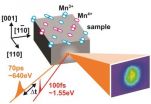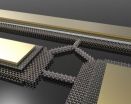(Press-News.org) Manganites – compounds of manganese oxides - show great promise as "go-to" materials for future electronic devices because of their ability to instantly switch from an electrical insulator to a conductor under a wide variety of external stimuli, including magnetic fields, photo-excitations and vibrational excitations. This ultrafast switching arises from the many different ways in which the electrons and electron-spins in a manganite may organize or re-organize in response to such external stimuli. Understanding the physics behind these responses is crucial for the future development of manganites.
In a recent study of praseodymium calcium manganite (PCMO) crystals, a model manganite system, researchers at Lawrence Berkeley National Laboratory (Berkeley Lab) discovered that under photo-stimulation the insulator/conductor switching, which depends primarily on charge-ordering, may be ultra-fast, but the re-ordering of electron-spin, upon which magnetic properties depend, is not. In fact, the re-ordering of spin in these materials actually exhibits a glass-like state, in which the restoration of crystalline order is substantially delayed.
"The electron-spins get trapped in a frustrated, disordered state, like cars trying to merge without road signs or lane markers, and can take multiple seconds, a comparatively very long time, to sort themselves out," says Robert Schoenlein of Berkeley Lab's Materials Sciences Division, one of the leaders of this study. "This separation of charge-ordering behavior from spin-ordering behavior may point the way to new approaches to manipulating spin effects for applications in switching and memory devices."
Working at beamline 6.0.2 of Berkeley Lab's Advanced Light Source (ALS), Schoenlein and a team that included Shuyun Zhou and Yi-De Chuang probed spin-ordering in PCMO crystals using a technique called time-resolved resonant soft x-ray scattering spectroscopy (TR-RSXS). In this technique, they pelted PCMO samples with 70 picosecond (trillionths of a second) pulses of x-rays to capture a series of snapshots that revealed how electron-spin ordering is re-established as the samples recover from a photo-excited conductor state back to the insulator state.
"We found that the glass-like behavior of the electron-spins arise from the metastable state created by photo-excitation, a state characterized by spin disordered metallic droplets within the larger charge- and spin-ordered insulating domains," says ALS staff scientist Chuang. "Comparison with time-resolved resistivity measurements suggests that the collapse of spin ordering is correlated with the insulator-to-metal transition, but the recovery of the insulating phase does not depend on the
re-establishment of the spin ordering."
Adds Zhou, "Our work provides a new perspective for revealing the fascinating physics hidden in the recovery dynamics
of electronic ordering in correlated electron materials after transient photo-excitation, a prominent method for ultrafast manipulation of material properties. Since other transition metal oxides that exhibit intriguing emergent phenomena, such as the high-temperature superconducting cuprates, also have rich competing phases involving dynamic electronic orderings, we should be able to extend similar TR-RSXS studies to those systems as well."
INFORMATION:
Lawrence Berkeley National Laboratory addresses the world's most urgent scientific challenges by advancing sustainable energy, protecting human health, creating new materials, and revealing the origin and fate of the universe. Founded in 1931, Berkeley Lab's scientific expertise has been recognized with 13 Nobel prizes. The University of California manages Berkeley Lab for the U.S. Department of Energy's Office of Science. For more, visit http://www.lbl.gov.
A glassy look for manganites
Berkeley Lab researchers at the ALS observe glass-like behavior in the electron-spins of PCMO crystals
2014-04-28
ELSE PRESS RELEASES FROM THIS DATE:
Ozone levels drop 20 percent with switch from ethanol to gasoline
2014-04-28
A Northwestern University study by an economist and a chemist reports that when fuel prices drove residents of São Paulo, Brazil, to mostly switch from ethanol to gasoline in their flexible-fuel vehicles, local ozone levels dropped 20 percent. At the same time, nitric oxide and carbon monoxide concentrations tended to go up.
The four-year study is the first real-world trial looking at the effects of human behavior at the pump on urban air pollution. This empirical analysis of atmospheric pollutants, traffic congestion, consumer choice of fuel and meteorological conditions ...
Risk of cesarean delivery 12 percent lower with labor induction
2014-04-28
The risk of a cesarean delivery was 12% lower in women whose labour was induced compared with women who were managed with a "wait-and-see" approach (expectant management), according to a research paper published in CMAJ (Canadian Medical Association Journal).
Labour is induced in about 20% of all births for a variety of reasons such as preeclampsia, diabetes, preterm rupture of the membranes, overdue pregnancy and fetal distress. Induction is often thought to be associated with increased risk of cesarean deliveries despite evidence indicating a lower risk. However, much ...
Catastrophic thoughts about the future linked to suicidal patients
2014-04-28
Suicide has been on the increase recently in the United States, currently accounting for almost 40,000 deaths a year. A new study shows that one successful effort to avoid suicide attempts would be to focus on correcting the distorted, catastrophic thoughts about the future that are held by many who try to kill themselves. Such thoughts are unique and characteristic to those who attempt suicide, says Shari Jager-Hyman of the University of Pennsylvania Perelman School of Medicine in the US. Jager-Hyman led a study, published in Springer's journal Cognitive Therapy and ...
Identification of genetic mutations involved in human blood diseases
2014-04-28
A study published today in Nature Genetics has revealed mutations that could have a major impact on the future diagnosis and treatment of many human diseases. Through an international collaboration, researchers at the Montreal Heart Institute (MHI) were able to identify a dozen mutations in the human genome that are involved in significant changes in complete blood counts and that explain the onset of sometimes severe biological disorders.
The number of red and white blood cells and platelets in the blood is an important clinical marker, as it helps doctors detect many ...
Stanford scientists create circuit board modeled on the human brain
2014-04-28
The Neurogrid circuit board can simulate orders of magnitude more neurons and synapses than other brain mimics on the power it takes to run a tablet computer.
Stanford scientists have developed a new circuit board modeled on the human brain, possibly opening up new frontiers in robotics and computing.
For all their sophistication, computers pale in comparison to the brain. The modest cortex of the mouse, for instance, operates 9,000 times faster than a personal computer simulation of its functions.
Not only is the PC slower, it takes 40,000 times more power to run, ...
Using a foreign language changes moral decisions
2014-04-28
Would you sacrifice one person to save five? Such moral choices could depend on whether you are using a foreign language or your native tongue.
A new study from psychologists at the University of Chicago and Pompeu Fabra University in Barcelona finds that people using a foreign language take a relatively utilitarian approach to moral dilemmas, making decisions based on assessments of what's best for the common good. That pattern holds even when the utilitarian choice would produce an emotionally difficult outcome, such as sacrificing one life so others could live.
"This ...
UEA research shows bacteria combat dangerous gas leaks
2014-04-28
Bacteria could mop up naturally-occurring and man-made leaks of natural gases before they are released into the atmosphere and cause global warming - according to new research from the University of East Anglia.
Findings published today in the journal Nature shows how a single bacterial strain (Methylocella silvestris) found in soil and other environments around the world can grow on both the methane and propane found in natural gas.
It was originally thought that the ability to metabolize methane and other gaseous alkanes such as propane was carried out by different ...
How to create nanowires only 3 atoms wide with an electron beam
2014-04-28
Junhao Lin, a Vanderbilt University Ph.D. student and visiting scientist at Oak Ridge National Laboratory (ORNL), has found a way to use a finely focused beam of electrons to create some of the smallest wires ever made. The flexible metallic wires are only three atoms wide: One thousandth the width of the microscopic wires used to connect the transistors in today's integrated circuits.
Lin's achievement is described in an article published online on April 28 by the journal Nature Nanotechnology. According to his advisor Sokrates Pantelides, University Distinguished Professor ...
First disease-specific human embryonic stem cell line by nuclear transfer
2014-04-28
NEW YORK, NY (April 28, 2014) – Using somatic cell nuclear transfer, a team of scientists led by Dr. Dieter Egli at the New York Stem Cell Foundation (NYSCF) Research Institute and Dr. Mark Sauer at Columbia University Medical Center has created the first disease-specific embryonic stem cell line with two sets of chromosomes.
As reported today in Nature, the scientists derived embryonic stem cells by adding the nuclei of adult skin cells to unfertilized donor oocytes using a process called somatic cell nuclear transfer (SCNT). Embryonic stem cells were created from one ...
UCLA scientists hunt down origin of Huntington's disease in the brain
2014-04-28
The gene mutation that causes Huntington's disease appears in every cell in the body, yet kills only two types of brain cells. Why? UCLA scientists used a unique approach to switch the gene off in individual brain regions and zero in on those that play a role in causing the disease in mice.
Published in the April 28 online edition of Nature Medicine, the research sheds light on where Huntington's starts in the brain. It also suggests new targets and routes for therapeutic drugs to slow the devastating disease, which strikes an estimated 35,000 Americans.
"From ...
LAST 30 PRESS RELEASES:
Orthopedics can play critical role in identifying intimate partner violence
Worms as particle sweepers
Second spider-parasitic mite described in Brazil
January 2026 issues of APA journals feature new research on autism, pediatric anxiety, psychedelic therapy, suicide prevention and more
Private equity acquired more than 500 autism centers over the past decade, new study shows
New cervical cancer screening guidelines from the US Department of Health and Human Services
Estimated burden of COVID-19 illnesses, medical visits, hospitalizations, and deaths in the US from October 2022 to September 2024
Smartphone use during school hours by US youth
Food insecurity and adverse social conditions tied to increased risk of long COVID in children
Earliest, hottest galaxy cluster gas on record could change our cosmological models
Greenland’s Prudhoe Dome ice cap was completely gone only 7,000 years ago, first GreenDrill study finds
Scientific validity of blue zones longevity research confirmed
Injectable breast ‘implant’ offers alternative to traditional surgeries
Neuroscientists devise formulas to measure multilingualism
New prostate cancer trial seeks to reduce toxicity without sacrificing efficacy
Geometry shapes life
A CRISPR screen reveals many previously unrecognized genes required for brain development and a new neurodevelopmental disorder
Hot flush treatment has anti-breast cancer activity, study finds
Securing AI systems against growing cybersecurity threats
Longest observation of an active solar region
Why nail-biting, procrastination and other self-sabotaging behaviors are rooted in survival instincts
Regional variations in mechanical properties of porcine leptomeninges
Artificial empathy in therapy and healthcare: advancements in interpersonal interaction technologies
Why some brains switch gears more efficiently than others
UVA’s Jundong Li wins ICDM’S 2025 Tao Li Award for data mining, machine learning
UVA’s low-power, high-performance computer power player Mircea Stan earns National Academy of Inventors fellowship
Not playing by the rules: USU researcher explores filamentous algae dynamics in rivers
Do our body clocks influence our risk of dementia?
Anthropologists offer new evidence of bipedalism in long-debated fossil discovery
Safer receipt paper from wood
[Press-News.org] A glassy look for manganitesBerkeley Lab researchers at the ALS observe glass-like behavior in the electron-spins of PCMO crystals



